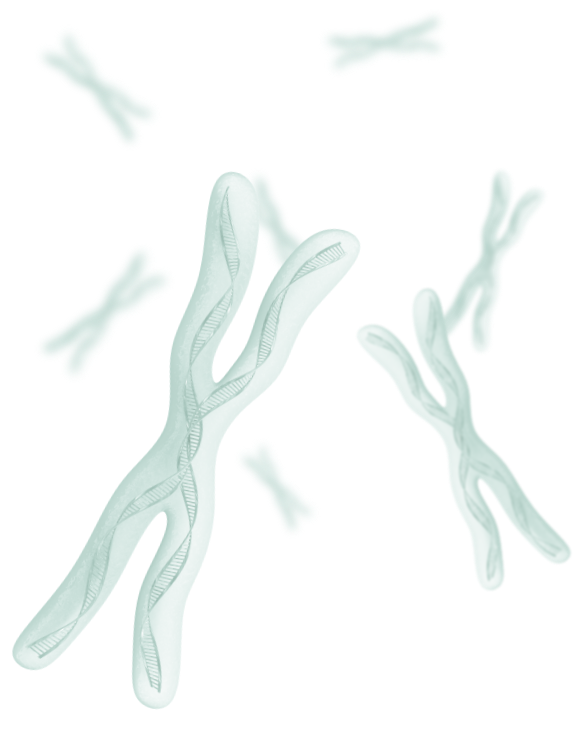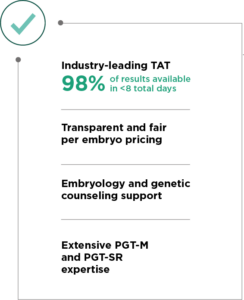Embryos with the usual number of chromosomes, also called euploid embryos, have a greater chance of becoming a healthy pregnancy and baby. Euploid embryos have 46 chromosomes and are created when a sperm with 23 chromosomes fertilizes an egg with 23 chromosomes. Sometimes embryos are created that do not have the usual number of chromosomes. These embryos, also called aneuploid embryos, are more likely to result in in vitro fertilization (IVF) failure. Aneuploidy also contributes to miscarriage and can be associated with health problems during pregnancy or following delivery. One of the most common examples of aneuploidy is trisomy 21, also referred to as Down syndrome, which is caused by the presence of a third copy of chromosome 21.

What is Preimplantation Genetic Testing for Aneuploidy (PGT-A)?
PGT-A is designed to identify which embryos have the correct number of chromosomes and thus have the greatest potential for a successful pregnancy.
Embryos with the normal number of chromosomes are called euploid embryos. Euploid embryos have 46 chromosomes and are created when a sperm with 23 chromosomes fertilizes an egg with 23 chromosomes. Sometimes embryos do not have the correct number of chromosomes (aneuploidy). Studies by Juno Genetics and its collaborators have shown that transfer of embryos diagnosed as having aneuploidy failed to deliver healthy babies.
Aneuploidy is a common cause of miscarriage and can be associated with problems in a developing pregnancy. The prevalence of aneuploidy increases with maternal age. One of the most common examples of aneuploidy is trisomy 21, also referred to as Down syndrome, which is caused by the presence of a third copy of chromosome 21.
What is PGTseq-A?
Aneuploidy screening through Juno Genetics utilizes targeted next-generation sequencing (tNGS). PGTseq-A has been developed following extensive analytical and clinical validation studies and identifies whole chromosome aneuploidy (extra or missing whole chromosomes). PGTseq-A is greater than 98% accurate in screening for whole chromosome aneuploidy. PGTseq-A also can detect some cases of segmental aneuploidy.
What is segmental aneuploidy?
Segmental aneuploidy refers to extra or missing genetic material from a part of a chromosome rather than from the whole chromosome.
In an internal study where embryos had multiple biopsies performed, the segmental aneuploidy was identified in approximately 50% of rebiopsy samples. Studies have also shown that embryos with segmental aneuploidies can result in a normal pregnancy. However, there have been reports of segmental aneuploidies identified in an embryo biopsy sample that were confirmed to be present in the fetus and resulted in abnormal ultrasound findings.
What is mosaicism?
Mosaicism refers to a potential combination chromosomally normal and chromosomally abnormal cells in a single embryo biopsy sample. Some studies suggest a mosaic result is associated with an increased risk for implantation failure and miscarriage. However, there is no consensus, and these studies are not conclusive. Additionally, embryos with mosaic results have resulted in children who were healthy at birth.
Since the significance of mosaic range results is uncertain, Juno Genetics refers to them as secondary findings of uncertain clinical significance. You and your provider have the option to decide whether you would like Juno Genetics to report results in the mosaic range.

Receive embryo biopsy samples

Analyze DNA

Report sent to your clinical team

Schedule IVF transfer
Juno’s PGT-A assay, PGTSeq-A, utilizes both a targeted next-generation sequencing (tNGS) assay and a single nucleotide polymorphism (SNP) assay for PGT-A. Juno uses targeted DNA amplification and is the only commercial laboratory that does not utilize whole genome amplification (WGA), as this method can contribute to noise and false-positive results. Targeted NGS only interrogates areas of the genome that provide an accurate assessment of whole chromosome aneuploidy (the primary indication for PGT-A), without introducing artifact.
Juno (formerly FEC Clinical Lab) has performed two key validation studies to assess the accuracy of the PGTSeq-A platform:
(1) A non-selection embryo transfer study (1), in which embryos were biopsied, tested on Juno PGTSeq-A, and transferred blinded to the PGT-A results. All 102 embryos deemed aneuploid by PGTSeq-A failed to result in an ongoing pregnancy, confirming that such embryos have little or no chance of producing a baby (0%; CI 0-2.4%).
(2) A blinded embryo rebiopsy study (2), in which embryos with clinical biopsies indicating euploid or aneuploid results were rebiopsied up to 4x to assess the reproductibility of the initial PGTSeq-A result. Whole chromosome aneuploid and euploid results were confirmed in all rebiopsies of the same embryo 97-99% of the time.
The rates of whole chromosome aneuploidy on PGTSeq-A are the lowest in the industry (3,4,5): 15% for the donor egg population, 29% for patients 35-37yo, 48% for patients 38-40yo, 68% for patients 41-42yo, and 84% for patients >42yo.
Juno classifies PGT-A results into two primary categories: negative or positive for whole chromosome (meiotic) aneuploidy. As a default, all mosaic findings are considered “negative for whole chromosome aneuploidy,” or normal results. However, providers may opt into the reporting of mosaic findings for any or all patients.
In a very large multisite, prospective study of almost 10,000 transfers of embryos tested on PGTSeq-A and negative for whole chromosome aneuploidy (6), the mosaic status of the embryos was blinded to the clinic. There was no significant difference in ongoing pregnancy rate, miscarriage rate, or livebirth rate between fully euploid and mosaic-result embryos, suggesting that there is limited clinical utility to reporting mosaic findings on PGTSeq-A. Nonetheless, providers and patients who wish to obtain this information may still opt in to receive mosaic findings on PGT-A results.
Juno’s PGTSeq-A assay utilizes information from both NGS (chromosome copy number) as well as SNPs (B allele frequency) to classify embryos as mosaic vs non-mosaic. This approach improves test accuracy over utilizing NGS alone, as there is no simple copy number or % cutoff that can be used to accurately classify embryos according to reproductive potential.
The most important role of SNPs in PGTSeq-A is to aid in discriminating between samples that are negative (euploid or, when reported, mosaic) versus positive for whole chromosome aneuploidy. Rather than using arbitrary percentage cuto s and ranges (e.g. 0-30%, 30-70%, 70-100%) to classify results, the combination of NGS (copy number) data and SNPs is used to make these calls. For example, a chromosome copy number of 1.3 (“70% mosaic monosomy”) could be deemed either positive or negative for aneuploidy (“mosaic”) depending on the corresponding SNP data.
Parental DNA is not needed for these analyses, and they are routinely included in PGTSeq-A at no additional cost and within the usual turnaround time.
In the PGTSeq-A rebiopsy study (2), in which embryos had multiple biopsies performed, non-mosaic segmental aneuploidies that had been detected in clinical PGTSeq-A results were confirmed in ~50% of rebiopsy samples. Embryos with segmental aneuploidy can result in a normal pregnancy and outcome; however, there have also been reports of segmental aneuploidies identified on PGT-A that were confirmed to be present in the resulting fetus in association with abnormal ultrasound findings.
Since the positive predictive value (rate of fetal confirmation) of segmental aneuploidy is not as high as that for whole chromosome aneuploidy, Juno lists these results separately on the PGT-A report.
Discrepancies between clinical PGT-A results and products of conception or CVS/amniocentesis results are thoroughly investigated and a formal follow-up assessment is issued to the clinician in all cases. When possible and with patient permission, Juno attempts to obtain residual DNA from POC or prenatal samples for DNA fingerprinting and further analysis to inform the most likely explanation for the discrepancy and for patient counseling.
Juno is committed to full transparency in data-sharing. Raw data (NGS copy number profile and SNP B allele frequency plot) is available for any embryo biopsy sample under the 21st Century CURES Act.

(1) Tiegs et al. A multicenter, prospective, blinded, nonselection study evaluating the predictive value of an aneuploid diagnosis using a targeted next-generation sequencing–based preimplantation genetic testing for aneuploidy assay and impact of biopsy. Fertil Steril 2021 Mar;115(3):627-637.
(2) Kim et al. The concordance rates of an initial trophectoderm biopsy with the rest of the embryo using PGT[A]Seq, a targeted next-generation sequencing platform for preimplantation genetic testing-aneuploidy. Fertil Steril. 2022 Feb;117(2):315-323.
(3) Bardos et al. Reproductive genetics laboratory may impact euploid blastocyst and live birth rates: a comparison of 4 national laboratories’ PGT-A results from vitrified donor oocytes. Fertil Steril. 2023 Jan;119(1):29-35.
(4) Fernández Sánchez et al. The choice of genetic service provider can have significant implications for the outcome of IVF cycles using preimplantation genetic testing for aneuploidy (PGT-A). ESHRE 202, P-724.
(5) Glynn et al. Genetic laboratories report significantly di erent aneuploidy rates for identical patient populations, a finding with important implications for clinics using PGT-A. ESHRE 2023, P-242.
(6) Gill P et al. Pregnancy outcomes of embryos diagnosed as putative mosaic (pm) using preimplantation genetic testing for aneuploidy (PGT-A): a multi-site blinded non-selection study. ASRM 2023, O-157.
(7) Yoder N et al. Assessment of genetic ploidy of tripronuclear embryos identifies few diploid blastocysts. ASRM 2021, P-146.
(8) Seckin S et al. Embryo rescue: Euploidy and whole chromosome aneuploidy rates in embryos initially categorized as 0N and 1PN at fertilization check. ASRM 2023, O-153.
(9) Kubicek DJ et al. Incidence and origin of meiotic whole and segmental chromosomal aneuploidies detected by karyomapping. Reprod Biomed Online. 2019 Mar;38(3):330-339.